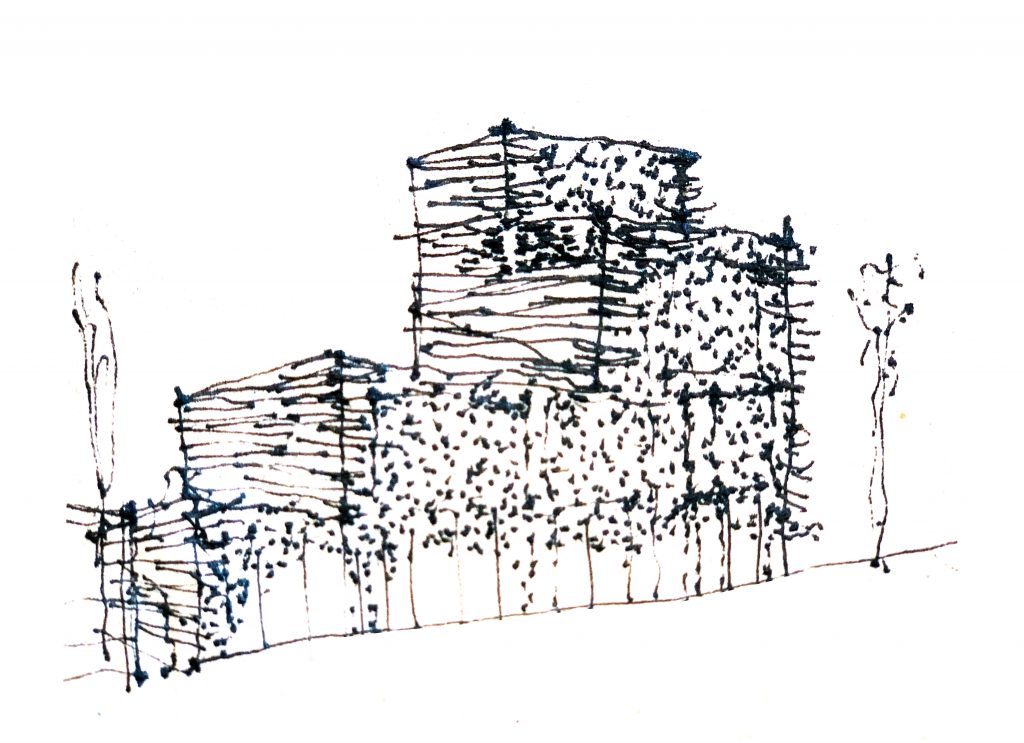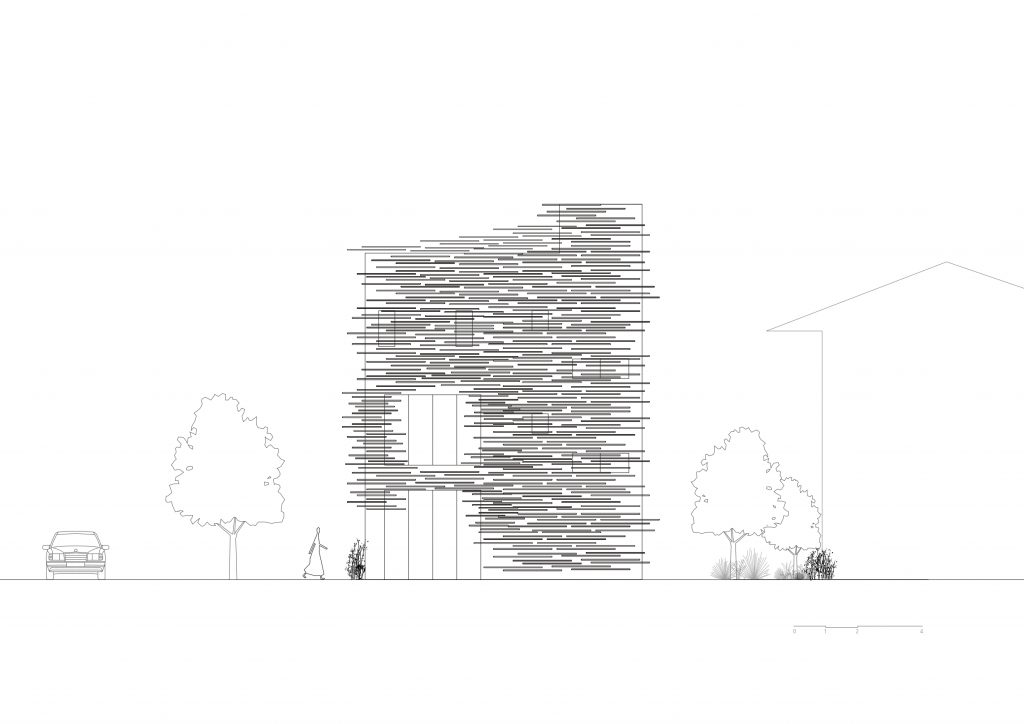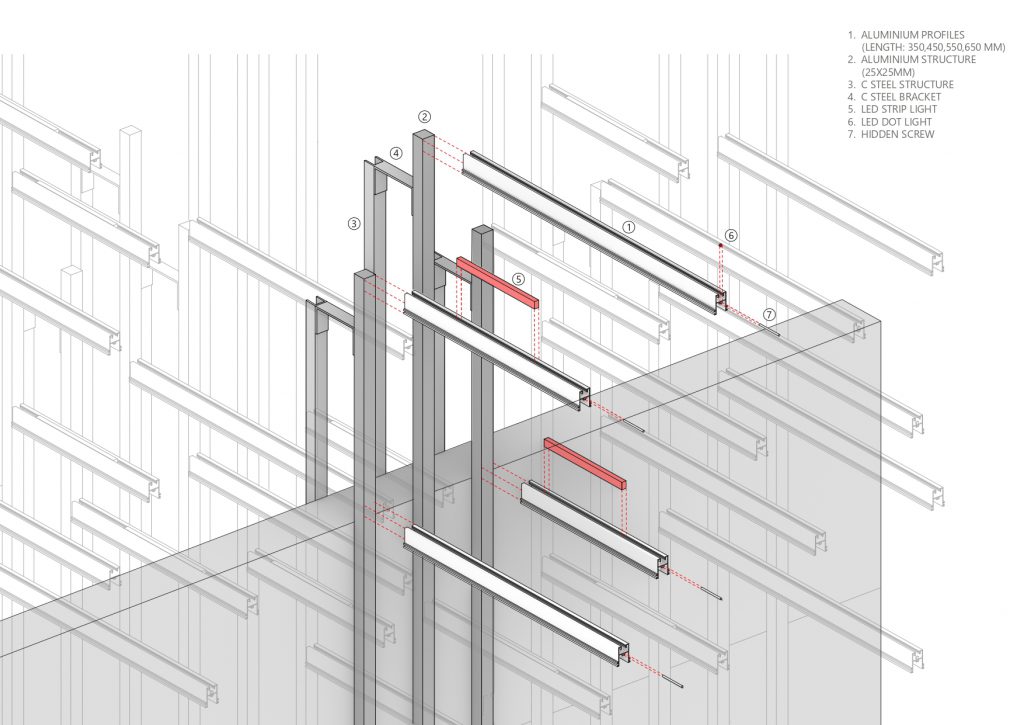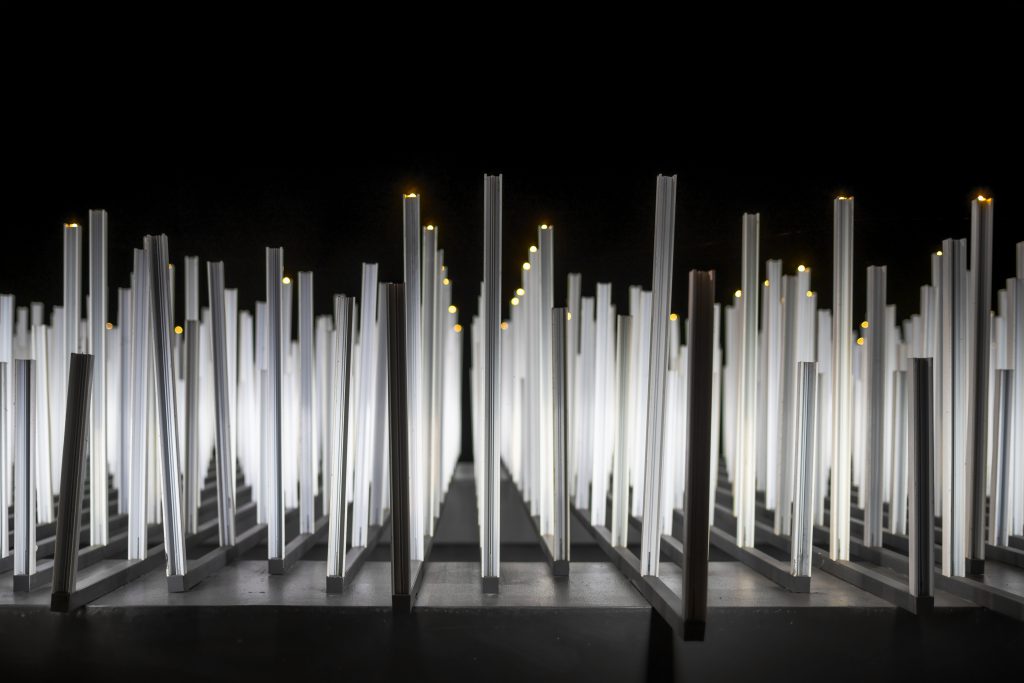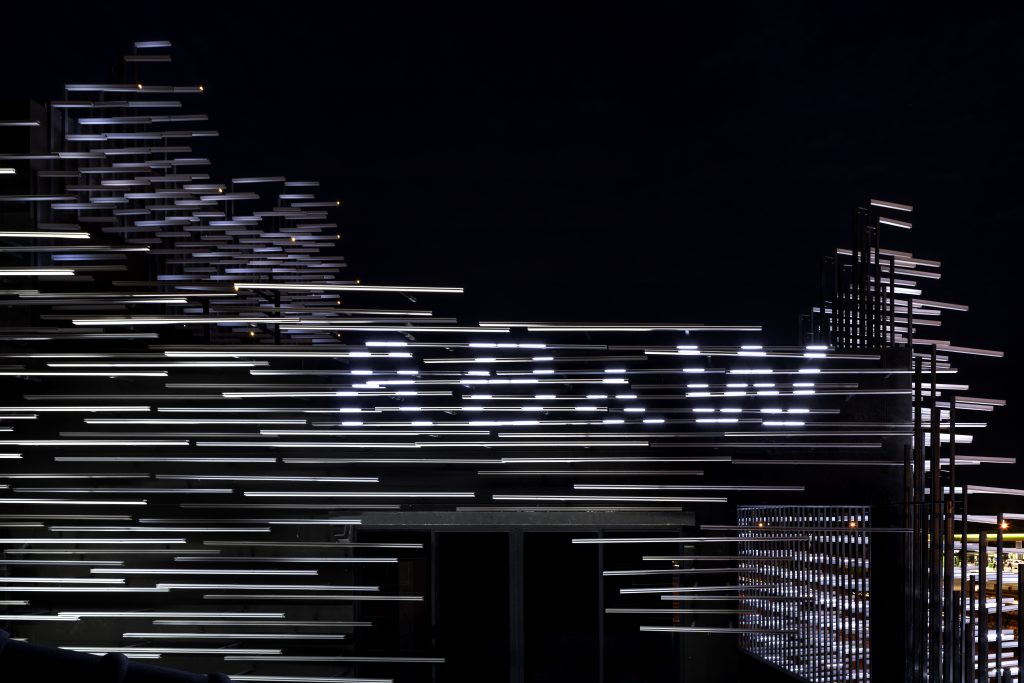HAS design and research, in collaboration with LIGHT IS, has created a new showroom for an aluminum manufacturer with dramatic facades in the form of a living organism, revealing itself in the most appealing manner possible when interacting with light.
Text: Xaroj Phrawong
Photo: W Workspace
Download the online journal Issue 06 Let There Be Light Click here

การรับรู้สถาปัตยกรรมได้ง่ายสุดคือการรับรู้ทางตา ส่วนที่สำคัญคือแสงที่ทำให้สามารถรับรู้รูปทรงได้ชัดเจนตามระดับความเหมาะสมของแสง แสงสร้างความหมายกับสถาปัตยกรรมได้ด้วยทิศทาง อุณหภูมิสี ความหมายที่สื่อจะชัดเจนได้ด้วยเงา ในประวัติศาสตร์สถาปัตกรรมจะเห็นได้ถึงความสัมพันธ์ของแสงกับสถาปัตยกรรมอย่างแยกไม่ออก แสงทำให้สถาปัตยกรรมมีตัวตน และส่วนที่ทำให้ตารับรู้ถึงการมีตัวตนของสถาปัตยกรรมได้ง่ายทางหนึ่งคือเปลือก เปลือกในงานสถาปัตยกรรมได้ทำหน้าที่บ่งบอกถึงการใช้สอยภายในจนเป็นภาษารูปแบบหนึ่ง สถาปนิกหลายยุคสมัยได้พัฒนาการสื่อสารด้วยภาษาทางสถาปัตยกรรมให้กับผู้รับสารเพื่อส่งข้อความให้เกิดการรับรู้ด้วยเปลือกภายนอกก่อนก่อนที่ผู้รับสารจะได้เข้าไปสู่การรับรู้สเปซภายในภายหลัง จนเมื่อเข้าสู่ยุคหลังสมัยใหม่ การสื่อสารผ่านเปลือกจากสถาปัตยกรรมโพสต์โมเดิร์น สถาปนิกผู้ออกแบบมีความต้องการบอกเรื่องราวของที่ตั้ง โปรแกรม มากกว่าเป็นสถาปัตยกรรมที่ดูเป็นศิลปะแบบนามธรรม ไร้ความสัมพันธ์กับถิ่นที่ใดๆ การใช้เปลือกสื่อสารข้อความจึงเป็นสิ่งที่พบเห็นได้มากขึ้น ในปัจจุบันพื้นที่ของกรุงเทพมหานคร และปริมณฑลกำลังเจริญเติบโตไปอย่างรวมเร็ว การเติบโตเหล่านี้ส่งผลต่อรูปแบบเปลือกของอาคารเหล่านี้ที่พบได้ทั่วไปในเอเชียอาคเนย์ เราสามารถพบความหลากหลายของเปลือกที่ห่อหุ้มที่แข่งขันแสดงตัวเอง ความน่าสนใจเหล่านี้ทางสำนักงานสถาปนิก HAS design and research นำโดย Jenchieh Hung และ กุลธิดา ทรงกิตติภักดี ได้สนใจทำการค้นคว้า พัฒนาสู่การออกแบบสถาปัตยกรรม พวกเขามองว่าการแสดงออกเหล่านี้เป็นสิ่งที่มีชีวิตชีวา เปรียบเปรยมันดัง ‘กิ้งก่า’ ในบริบทเมือง ในความสนใจนี้ เปลือกมีการแปรเปลี่ยนตามบริบทแวดล้อม บอกถึงเรื่องราวของที่ตั้ง และโปรแกรม
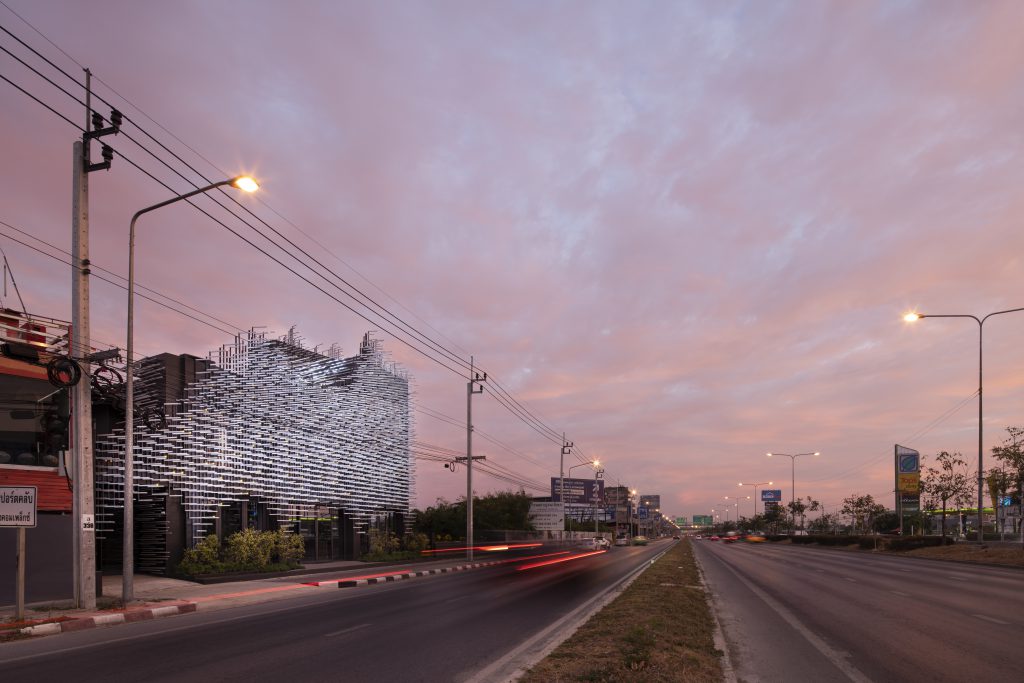
ณ ถนนราชพฤกษ์ อำเภอปากเกร็ด นนทบุรี ปรากฏอาคารสีเทาเข้ม เปลือกดูแปลกตาจากสภาพแวดล้อมโดยรอบ มันคือโชว์รูมของ AB&W Innovation ในชื่อว่า MoMA (Museum of Modern Aluminum) AB&W ดำเนินกิจการเกี่ยวกับผลิต จำหน่าย ประตูหน้าต่างอลูมิเนียมมพร้อมอุปกรณ์ MoMA เริ่มเปิดการใช้งานเมื่อต้นปี พ.ศ. 2565 โชว์รูมนี้ถูกออกแบบด้วยการต่อยอดจากการค้นคว้า วิจัย แล้วขมวดสู่การออกแบบโดย HAS design and research งานนี้เริ่มต้นจากการค้นคว้าที่เป็นความสนใจของสถาปนิก จากการที่มองสภาพเมืองในกรุงเทพมหานครที่มีการเปลี่ยนแปลงในลักษณะ ’ด้น’ (improvise) จากสิ่งที่อยู่รอบตัวตามบริบท อย่างการครอบครองพื้นที่ของการขึงหลังคาผ้าใบแบบกึ่งชั่วคราว การหุ้มเปลือกด้วยป้ายเหล็กรูปแบบต่าง ๆ จนองค์ประกอบที่ดูไม่เป็นเนื้อเดียวกันเหล่านี้ได้รวมเป็นสถาปัตยกรรมพื้นถิ่นเมืองที่มีรูปแบบเฉพาะในแบบที่อุปมาอุปไมยได้ดังกิ้งก่าเมือง ซึ่งผิวหนังของพวกมันสามารถปรับตัวได้ตามฉากหลังที่พวกมันอยู่
โจทย์ที่สถาปนิกได้รับคือการปรับปรุงอาคารเก่า ซึ่งเป็นตึกแถว 2 ห้อง และบ้านเดี่ยวที่เป็นบ้านจัดสรร 2 ชั้น ตามรูปแบบที่พบได้ทั่วไป ให้กลายเป็นโชว์รูมหลังใหม่ มีความโดดเด่นในตัวมันเอง พร้อมกับสามารถนำเสนอเรื่องราวของสินค้าได้ดี จึงเป็นจุดเริ่มต้นให้สถาปนิกทำการค้นคว้า สำรวจ ถึงความเป็นไปได้สำหรับการออกแบบ สู่ประเด็น ‘แสงจากเรื่องราวของโปรแกรม’ จากการค้นคว้า สถาปนิกพบถึงความน่าสนใจของส่วนประกอบของวงกบอลูมิเนียมในส่วนของรางหิ้วประตูหน้าต่างบานเลื่อนด้านบน ซึ่งเป็นแบบมาตรฐานทั่วไป แต่มันถูกซ่อนอยู่ในวงกบที่เรามองผ่านมันด้วยความชินตา สถาปนิกเลือกรางอลูมิเนียมมาผ่าแนวขวาง แล้วทำการศึกษาให้กลายเป็นองค์ประกอบหลักในการเปลี่ยนโฉมอาคารเก่าหลังนี้ จากนั้นได้ทำการทดลองสร้าง pattern ของรางให้ยื่นพุ่งออกมาผนังอาคารตั้งฉากสู่ถนนราชพฤกษ์ การออกแบบความยาวของราวจำนวนมากเหล่านี้มีขนาดความยาวต่างกันไป ทำให้เกิดความเคลื่อนไหวของเปลือก หากมองผ่านอย่างรวดเร็วจะเหมือนว่ามันไม่ได้มีรูปแบบการยื่นที่เป็นระบบ แต่สิ่งที่สถาปนิกศึกษาผ่านหุ่นจำลอง แผนภาพ มันมีรูปแบบการซ้ำอย่างละเอียดเป็นระบบที่ใช้เทคนิคสลับไปมาของ pattern การติดตั้ง รางเหล่านี้สถาปนิกเลือกใช้อลูมิเนียมแบบสีธรรมชาติ ทำให้โดดเด่นออกมาในเวลากลางคืน ผนังด้านทิศตะวันออกส่วนที่ขนานไปกับถนนราชพฤกษ์รางอลูมิเนียมถูกวางให้ตั้งฉากกับผนังอาคาร แต่ผนังด้านทิศเหนือรางอลูมิเนียมถูกวางแนบไปกับผนังอาคารเดิม เทคนิคการติดตั้งรางอลูมิเนียมถูกยึดประกอบเข้ากับโครงเคร่าอลูมิเนียมสีดำแนวตั้ง ทำให้โครงที่รับรางยื่นเปล่านี้พรางตัวไปกับอาคาร ซึ่งสถาปนิกต้องการให้ลดความโดดเด่นลงด้วยการทาสีเทาเข้ม เพื่อให้เปลือกปรากฏตัวมันเองจากความมืดด้วยแสงไฟโดดเด่นมากที่สุด รายละเอียดของรางอลูมิเนียมเหล่านี้ ถูกติดตั้งด้วยหลอด LED สีขาวแบบยาวขนานไปกับร่องรางอลูมิเนียมด้านบน ทิศทางการส่องแสงจึงเป็นแบบ up light กับเปลือก ส่งผลให้ตัวอาคารดูเบาขึ้นในเวลากลางคืน ผลลัพท์เหล่านี้เป็นผลจากการร่วมงานกับ Light Is ผู้เป็น Lighting Designer โครงการนี้
ถนนราชพฤกษ์ในอดีต เป็นพื้นที่สวนที่มีความสมบูรณ์ ต่อมาได้ถูกพัฒนาเป็นเมืองจนกลายเป็นเมืองที่เราพบได้ในปัจจุบัน แต่ความอุดมสมบูรณ์จากธรรมชาติเปล่านี้ยังสามารถหาได้ในพื้นที่ไม่ไกลจากที่ตั้งในเกาะเกร็ด เมื่อเริ่มออกแบบเปลือกและแสงแล้ว สิ่งที่สถาปนิกคิดควบคู่ไปพร้อมกันคือประเด็น ‘แสงจากเรื่องราวของถิ่นที่’ สิ่งที่สถาปนิกหวนคิดถึงคือแสงจากหิ่งห้อยในยามค่ำคืนที่เกาะเกร็ด จากนั้นจึงได้มีการออกแบบแสงที่สื่อถึงเรื่องราวของหิ่งห้อยด้วยการติดตั้งไฟแบบจุดสีเหลืองที่ปลายรางอลูมิเนียมเพียงเล็กน้อย แต่ให้กระจายไปยังเปลือกโดยรอบ แสงไฟเหล่านี้ถูกโปรแกรมให้ส่องสว่างแบบต่างกันไปตามช่วงเวลา สำหรับแสงเลียนแบบหิ่งห้อยเหล่านี้จะปรากฏชัดเจนในยามดึก หลังจากดับหลอดไฟสีขาวบนรางแล้ว
นอกจากการเปลี่ยนโฉมด้วยแสงกับรางอลูมิเนียมในส่วนภายนอกแล้ว พื้นที่ภายในบางส่วนได้ถูกออกแบบให้ใช้รูปแบบเดียวกัน และเป็นส่วนสำคัญสำหรับงานนี้คือส่วนทางเข้าพิเศษด้านทิศใต้ ช่องทางเข้านี้มีขนาดกว้างราว 2 เมตร ลึกไปตลอดความยาวอาคาร ผนังด้านข้างและเพดานถูกหุ้มด้วยรางอลูมิเนียมเช่นกับเปลือกภายนอก รางขนาดความยาวต่าง ๆ ถูกออกแบบคละกันไปให้พุ่งสู่ปลายผนังด้านใน การติดตั้งทิศทางรางและหลอดไฟ LED บนผนังด้านข้างออกแบบแตกต่างจากภายนอกที่มีลักษณะหงายขึ้น เป็นการติดตั้งให้แนวรางหันเข้าสู่พื้นที่ทางเดินตรงกลาง ส่วนเพดานใช้วิธีหันราง และหลอดไฟ LED ลงด้านล่าง ส่วนปลายผนังของทางเข้าเมื่อมองครั้งแรกแบบไม่ดูถึงรายละเอียดก็คล้ายการกรุกระเบื้องโมเสคขนาดเล็ก แต่เมื่อเข้ามายังพื้นที่ส่วนนี้ จนเดินเข้าไปพิจารณาถึงส่วนปลายผนังระนาบนี้แล้ว สายตาได้พบกับรายละเอียดจากการนำรางอลูมิเนียมมาผ่าแนวขวางเป็นท่อนขนาดเล็ก จากนั้นทำการกรุเข้าไปยังผนังแบบชนิดที่ไม่มีช่องว่าง ผลลัพท์ทางสายตาของทางเข้าส่วนนี้ ทำให้เกิดเส้นที่รุนแรงแบบทัศนียภาพจุดเดียวจากเส้นของรางอลูมิเนียมและแสง ช่วยขับเน้นผู้ที่เลือกจะเดินเข้ามายังโชว์รูมด้วยทางเข้านี้ชนิดที่เรียกได้ว่าเป็นมุมขึ้นกล้องของช่างภาพ
ในวันที่ผู้เขียนไปเยือนงานนี้ในเวลาเย็นจนค่ำ ได้ดูแสงของเปลือกงานนี้ในรูปแบบต่าง ๆ จากเวลาต่าง ๆ จนครบ ชวนให้คิดว่าหากพระเจ้าอยู่ในรายละเอียดแล้ว งานนี้มีพระเจ้าที่เรามองข้ามไปในคราวแรก จนค่อย ๆ มองรายละเอียดในเวลาต่าง ๆ กัน พระเจ้าจะปรากฏพร้อมแสงที่ผู้ประดิษฐ์รอให้พบตามเวลาที่นัดไว้กับพระเจ้าบนถนนราชพฤกษ์

The easiest way to experience architecture is through visual perception, and light contributes as a key factor to humans’ perception of forms, which can also be varied by the amount and intensity of the light source itself. Light can give meaning to a work of architecture through its directions, color temperatures as well as by the shadows it creates. Throughout the history of architecture, the relationship between light and built structures has been inseparable. Light brings architecture into existence and one of the things that makes a work of architecture visually appealing is its ‘skin’. A purposefully designed building skin or façade can be an interesting implication of the building’s interior functionality; a form of language uttered to send out the intended message, so to speak.
Through time, architects have searched for ways to communicate their architectural languages to people on the receiving end, designing skins that give users different introductory messages before they actually start experiencing the interior spaces. The architecture of the postmodern world has seen new possible approaches to communicate with users through postmodern façade designs. Architects work from the desire to tell the story of a location and program rather than to create architecture that looks and feels like an abstract art piece where the connection to locality is nowhere to be found. This has led to the growing popularity of façades, used to help architects send the intended messages. The rapid urban expansion of the Bangkok metropolitan region has influenced the evolution of façades, an architectural component found almost everywhere in Southeast Asia. We can see and have seen great diversity in façade design; each conceptualized and materialized to make its own statement. The evolution strikes the interest of HAS design and research led by Jenchieh Hung and Kulthida Songkittipakdee. This architectural practice develops its architectural design based on their research and perception toward the architectural expression of façades as a form of a living organism—a chameleon of an urban jungle. From HAS’ perspective, a building skin changes and evolves according to its surrounding context, telling stories of the location and program it was created in.
On Ratchapruek Road, in Pak Kret district of Nonthaburi province sits a dark grey building with the skin that sets the structure apart from its surrounding environment. The building is the showroom of AB&W Innovation, the company with business operations in manufacturing and distribution of aluminum door and window frames and fittings. Named MoMA (Museum of Modern Aluminum), the showroom officially opened in early 2022. HAS began their work on the project with research before proceeding to the design process. The origin of the project, however, is rooted in the design team’s interest and observation of the improvisational developments of Bangkok’s urban space. Different urban and architectural elements improvise from their surrounding contexts such as the use of tarpaulin roof structure to cover or claim a certain space, the wrapping of a building skin with any imaginable designs and styles of aluminum signboards. The disparity of these components has somehow collectively evolved into a unique vernacular characteristic; one that can be metaphorically compared to an urban chameleon whose skin camouflages itself into and according to its surroundings.

The design team was given the brief to renovate two units of shophouse and a two-story single detached home, both are residential typologies commonly found in Bangkok. The new showroom stands out with its visually striking architecture that serves as a perfect representation of the company’s business and products. The requirements became the starting point for the design team to carry out the research and explore different design possibilities, which eventually led to the idea of ‘light from the story of the program.’ The research reveals some interesting attributes of the components of the aluminum frames used in standard railing systems, particularly the upper part of a sliding door and window system. These components are hidden in the frame that most users tend to overlook. The architects dissected the aluminum strips horizontally to study its components, before using them as the key element of the renovation. A pattern created from aluminium strips was then drafted and tested with the design of the façade, which protrudes from the building’s exterior wall in a 90-degree angle with Ratchapruek Road.
The design deals with the varying lengths of the strips and creates a façade with dynamic movements. A quick glance will make the protrusion seem randomized, while in reality the design is the result of intensive research and study, through models, diagrams, causing the façade to possess detailed and systematic repetition of alternating patterns. The architects chose to use the aluminum in its natural color, making the façade stand out during the night. Another aluminum strip skin can be found on the east wall, installed in a 90 degree angle along the building’s exterior wall, which rests along Ratchapruek Road. For the north wing, the strips have been placed right on the original wall. The installation techniques fasten the aluminum to the vertical black aluminum frames that blend into the building’s exterior. The overall architectural mass is painted in dark grey to soften the dramatic effect, allowing the façade to reveal itself in the darkness in the most appealing manner possible when interacting with light. The rails are equipped with white LED bulbs, which run in parallel with the aluminum strips installed at the upper part of the façade. The direction of uplight accentuates the façade’s unique physical appearance and makes the building appear lighter at night. HAS collaborates with Light Is, the project’s lighting designer, to achieve this final outcome.
In the past, Ratchapruek Road was home to vast green areas of orchards before the urban sprawl reached the suburban neighborhood and turned it into a more urbanized residential area. The richness of nature, however, can be found in Koh Kret, an island located not too far from the site’s location. Evolving alongside the design of the façade and magical lighting design is the ‘light from a local story.’ The architects recreate the lights from fireflies that used to populate the Koh Kret area with their nighttime appearance with the lighting design where small LED bulbs are installed at the tip of the protruding aluminum strips. The miniature light bulbs are scattered throughout the surface of the façade and programmed to have varying illumination effects at different times of day. The firefly light can be seen more clearly later in the night, after the white light on the strips goes out.

The transformation is not brought about only through lighting and aluminum strip installations, but through the redesigned interior program, which stylistically corresponds with the design of the exterior. One of the highlights of the project is the south wing entrance, which is designed to have a two-meter width, and installed with the same skin along and throughout the narrow side of the building. Just like the façade, the sidewalls and ceiling are clad with aluminum strips of varying lengths in a calculated randomized configuration, leading visitors toward the furthest end of the walls. The direction of the strips and LED bulbs on the sidewalls is slightly different from the ones on the exterior skin where the installation is turned upward. With the interior, the strips are directed toward the tunnel’s walkway while the strips and LED bulbs on the ceiling face downward. The furthest end of the tunnel reveals what looks like a pattern of tiny mosaic tiles at first glance. In reality, a closer look at the material reveals the details of aluminium strips, cut horizontally into small pieces, and used to clad every square meter of the wall. These elements render the end result of a dramatic focal point created by the pattern of aluminium strips and lighting, which work in tandem to make the space look stunningly photogenic when captured by a camera.
On the day of my visit, it was already past nightfall, so luckily I was able to see the façade evolve into all its forms. The work got me thinking that if God really is in the details, then I must have failed to see one on my first encounter with the work. This time around, as I looked at the details, at different times of day, God appeared, along with the light, just like how the architects must have intended for us to meet, at specific times and places, right here on Ratchapruek Road.



